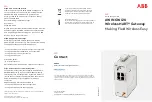
ABB i-bus
®
EIB
Appendix
© 2006 ABB STOTZ-KONTAKT GmbH
90
OK. A lamp fault is indicated by a red X on the lamp symbol. If a ballast fault
is detected, the lamp symbol disappears and only the red X is visible. A
ballast fault can have many causes:
•
The ballast is defective
•
The ballast is not connected to operating voltage
•
The ballast has been exchanged and has another DALI address
A ballast fault will only be correctly recognised if the ballast detection
function has been implemented beforehand. The number of devices and the
DALI addresses are stored when this function is run and used as a reference
value by the DALI-Gateway. If this state changes, it will be determined as a
ballast fault. The “Detect Ballasts” function can be activated in two ways:
- by an EIB / KNX telegram with the value “1” which is sent by the
“Detect Ballasts” object.
- by an extended operation of the test button. The push button action
must be for longer than 5 seconds.
A.1.5
Meaning of the symbols
The displayed symbols have the following meaning:
DALI device recognised and status OK (no lamp or ballast fault)
DALI device reports a lamp fault
DALI device no longer available (ballast fault)
A fault in the channels is indicated by a “!” on the “Channel x” (x = A, B) tab.
This can be due to a ballast or lamp fault.
The following additional symbols indicate the configuration mode:
Every DALI device detected is displayed by a lamp symbol.
If the DALI device is selected, it will be displayed by a lit lamp
symbol.
















































